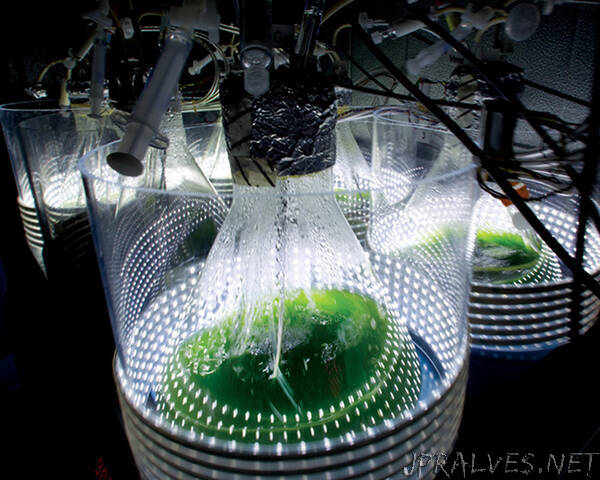
“AI accelerates research into Earth-friendly materials that soak up CO2 and break the dependence on fossil feedstocks for everyday products
Getting a grip on climate change depends on shifting from CO2-emitting fossil fuels to renewable energy sources. When that happens, where will we get all the plastic we need for, well, nearly everything?
Most plastics today come from petroleum. About three-quarters of every barrel of oil goes to make gasoline, diesel and jet fuel; the remaining quarter goes to other products, including plastic. Making it from petroleum is doubly problematic as it helps perpetuate our global dependence on fossil energy and it continues the long-term environmental degradation caused by synthetic plastics, which can take several hundred years to break down into simpler materials.
The entwined challenges of transitioning to renewable, non-fossil energy sources and developing environmentally friendly plastics highlight the breadth of the broader challenge of decarbonizing our economy for a sustainable future. That’s the mission of a new coalition led by Los Alamos National Laboratory, the Intermountain West Energy Sustainability & Transitions initiative. Sponsored by the Department of Energy, the broadly inclusive I-WEST initiative brings together states, regional universities and colleges, research institutions, local communities and Native American tribes and nations to create a sustainable-energy economy.
Much of I-WEST’s work focuses on lowering emissions from energy, as it should, but bioproducts and bioplastics play a big role, too—and for good reason. Single-use plastics, which include everything from water bottles, grocery bags and food packaging to drinking straws, make up about half of the world’s estimated 380 million tons of global plastic waste each year. The plastic debris of the Great Pacific Garbage Patch covers an area twice the size of Texas. When plastics do break down in the environment, their fragments called “microplastics” accumulate everywhere, even in human lungs.
Fortunately, there’s a way to turn the tide: bioplastics. Produced from microorganisms, bioplastics are key to decarbonizing our economy while addressing the pollution problem. Right here in the desert Southwest, photosynthetic cyanobacteria, or blue-green algae, can be cultivated with sunlight and CO2 captured from power plants, industrial processes or directly from the air. Carbon storage molecules harvested from the microbes then provide the raw material for making bioplastics.
While manufacturers are working to improve bioplastics, developing economically viable alternatives to synthetic plastics requires basic scientific research, fast.
It’s a sticky problem. Plastic is made of polymers, long chains of molecules with useful mechanical properties, such as strength and elasticity. Polymers can be easily formed into almost limitless shapes or into fibers for textiles. But those long chains of molecules come in all sorts of configurations. Figuring out which algae, for instance, can produce the polymers necessary to create a plastic with the most desirable properties is a time-consuming and expensive task, drawing heavily on biology and chemistry and riddled with inevitable holes in the data.
A large, multidisciplinary project called BioManufacturing with Intelligent Adaptive Control is addressing those problems. As one part of the suite of technologies and basic scientific research Los Alamos is contributing to the I-WEST effort, BioManIAC brings together biologists, polymer chemists, and material engineers with AI experts helping to speed the path to discovery and using Lab-developed software tools to design and develop new biodegradable plastic materials.
In a kind of virtual laboratory, polymer engineers can use AI to screen a vast number of polymer chemistries, predict their properties, and tune new biopolymers, rather than actually making and physically testing them all. This way, BioManIAC will help slash research and development expenses and accelerate creating a new marketable product.
The Los Alamos team that developed the BioManIAC software is also using AI to understand more about the algae genes involved in synthesizing the biopolymers. The genes can then be manipulated to increase yield or confer different chemistries to the molecules, leading to better mechanical properties. Finally, the team plans to develop AI software that can, for example, virtually test additives and the effects of polymer blends in the material when making it to optimize its large-scale production.
Growing the bioeconomy in the region, as I-WEST envisions, will require more than just an energy transition but also complementary products that can be made from sustainable biomass. Making the development of biopolymers more accessible is a dramatic step forward along that path. It supports growth of the sustainable plastic economy while reducing our dependence on fossil fuels, providing a new place to store carbon removed from the atmosphere, and reducing the plastic burden on the environment. That’s a win for everybody.
Babetta Marrone is a bioscientist who conducts research into bioenergy and bioproducts based on algae. She leads the Bioeconomy thrust of the I-WEST initiative.
LA-UR-22-23288”
